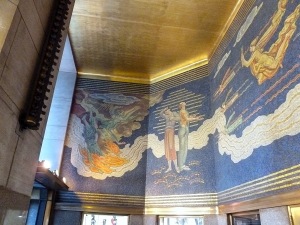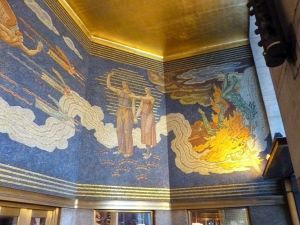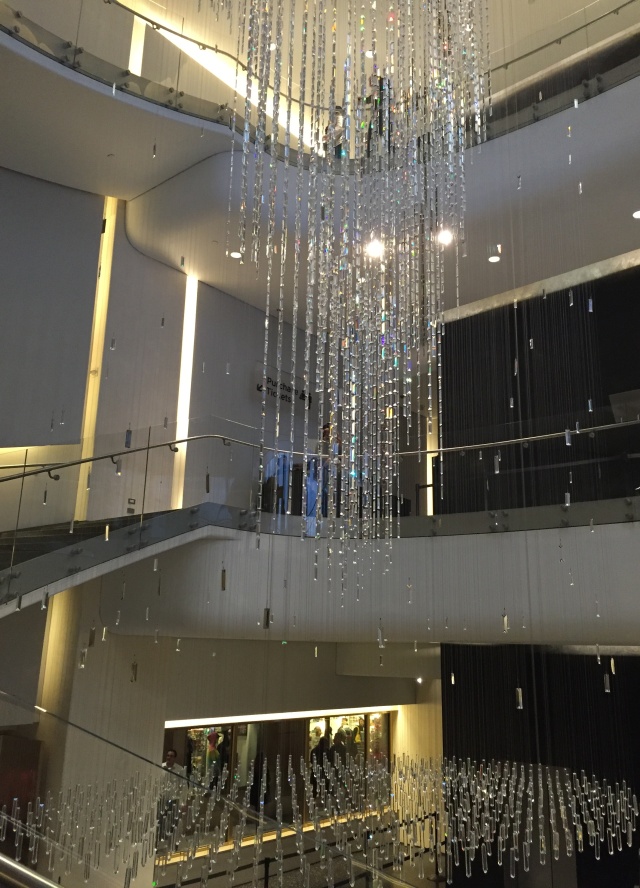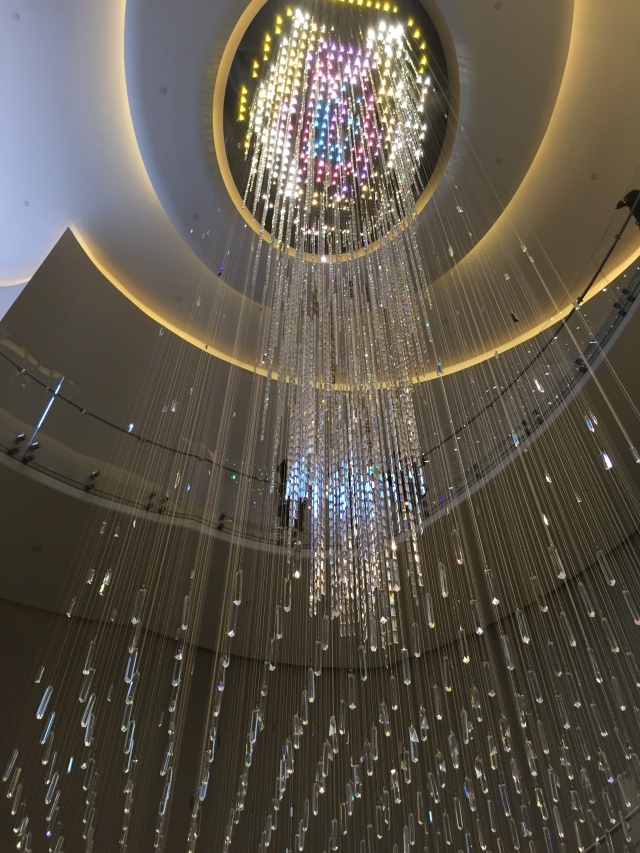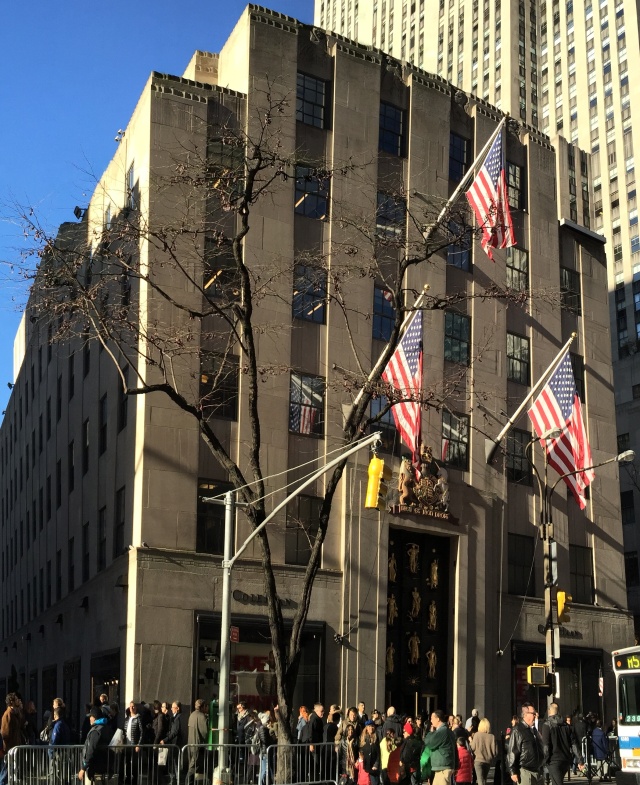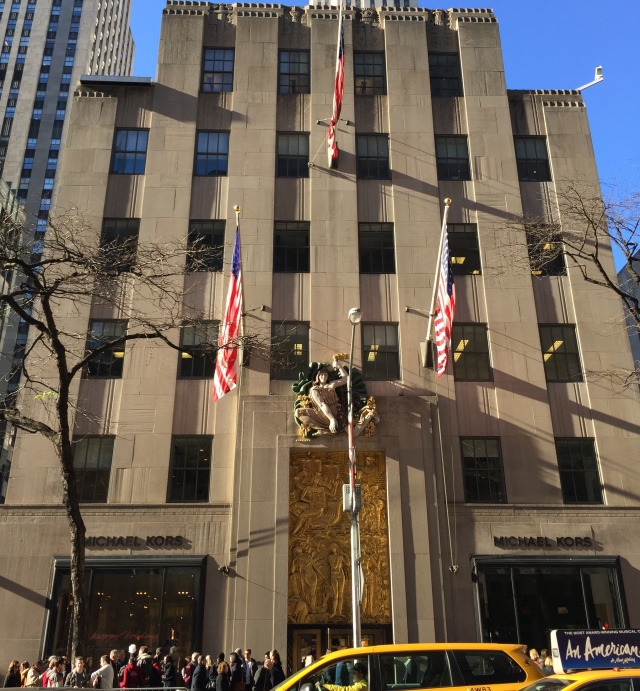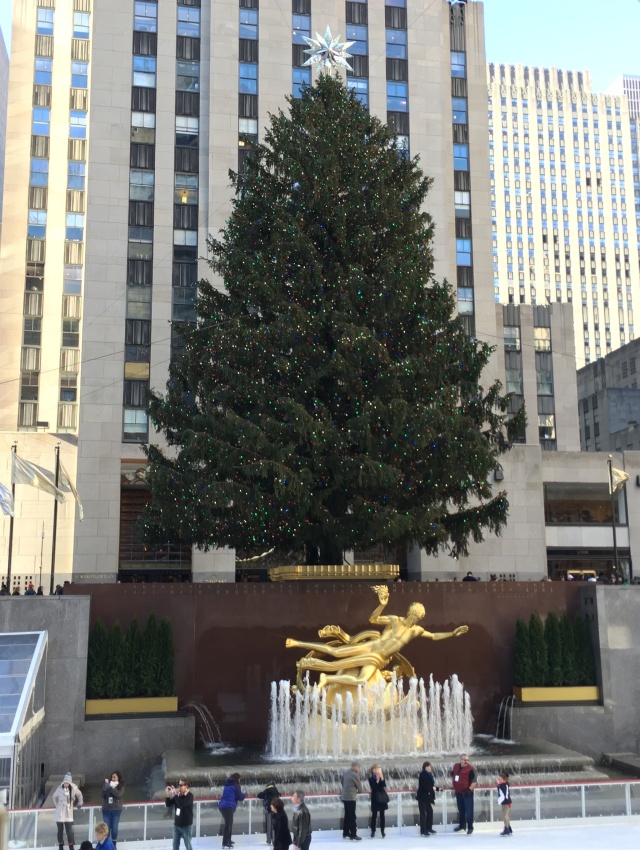Originally known as Radio City, Rockefeller Center (洛克斐勒中心) is the largest private construction project of the 20th century, developed in the midst of the Great Depression. The complex initially consisted of 14 buildings, the 70-story RCA building being the tallest. There are now 19 buildings and plazas in Rockefeller Center, housing such famous places as Radio City Music Hall, the Rainbow Room, and the NBC’s shows like “Today" and “Saturday Night Live." They are all connected by a series of underground tunnels which, themselves, support a variety of shops.
 Today Rockefeller Center is a favorite spot to visit for visitors, particularly at the holiday season, hosting the famous annual Christmas Tree in front of the central feature of the complex—Comcast Building. (Follow the promenade down to the Center, allowing an unobstructed view as the tower soars upward like the prow of a huge ship.)
Today Rockefeller Center is a favorite spot to visit for visitors, particularly at the holiday season, hosting the famous annual Christmas Tree in front of the central feature of the complex—Comcast Building. (Follow the promenade down to the Center, allowing an unobstructed view as the tower soars upward like the prow of a huge ship.)
p.s. In 1969, the complex was the first recipient of the American Institute of Architects’ prestigious Twenty-Five Year Award given to buildings whose design has stood the test of time for at least 25 years. In 1987, Rockefeller Center was declared a National Historic Landmark.
History of Rockefeller Center The area where Rockefeller Center is located was originally planned as the new location for the Metropolitan Opera. At the time the area situated between 48th and 51st streets and Fifth and Sixth avenues was a red-light district owned by Columbia University. John D. Rockefeller Jr. leased the area on behalf of the Metropolitan Opera in 1928 (a 27-year lease with the option for three, 21-year extension). First the design of the complex was created by the American architect Benjamin Wistar Morris. His plan, influenced by the Grand Central Terminal complex included a landscaped garden and a monumental Opera House as well as tall office towers, shops and terraces. The buildings would be connected by a series of bridges and walkways. It was conceived as a “City within a City"— the first real estate development in the world to include offices, retail, entertainment, and restaurants in one complex. However the stock market crash of 1929 caused the Metropolitan Opera to abandon the ambitious project. Rockefeller then launched a new plan for a corporate complex to house the new radio and television corporations. Radio City was born. A 12-acre complex of the original 14 limestone buildings, represented 6 million square feet of rentable space, designed by a team of architects headed by Henry Hofmeister, H.W. Corbett, and Raymond Hood. This group of skyscrapers erected between 1930 and 1940, at a cost of $100 million, was one of the largest projects ever undertaken by private enterprise, employing nearly 75,000 workers. The Art Deco design, both architectural and decorative, of the original buildings is some of the world’s finest. Then between the 1950s and 1970s, four International-style office towers were built on the west side of the Avenue of the Americas (Sixth Avenue), expanding the Center’s boundaries. The latest addition to Rockefeller Center was the Lehman Brothers Building at 745 Seventh Avenue, which opened in 2001.
p.s. The first and largest corporate tenant of Rockefeller Center was the Radio Corporation of America (RCA), the parent company of NBC at that time. It was known before construction began that the main building would be the home of NBC studios in New York from which they would broadcast radio and television. For this reason, early on in the complex’s construction, the area garnered the nickname “Radio City". And this is of course how the famous concert hall got its name.
Buildings in the Rockefeller Center The current Rockefeller Center is a combination of two building complexes: the original 14 Art Deco office buildings from the 1930s and a set of four International-style towers built along the west side of Avenue of the Americas during the 1950s and 1970s (plus the Lehman Brothers Building). It has 19 buildings in total (22 acres /89,000 m2), stretching from Fifth and Seventh Avenue east to west and 48th St. to 51st St. south to north in Manhattan.
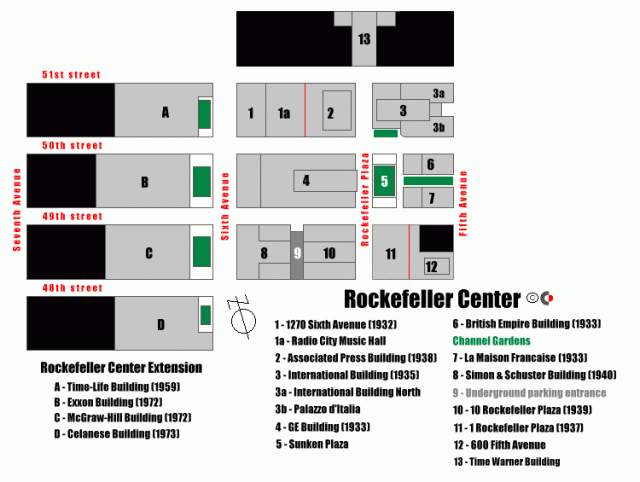 (via http://www.nyc-architecture.com/)
(via http://www.nyc-architecture.com/)
The Art of Rockefeller Center Rockefeller Center is home to a remarkable collection of Art Deco motifs and sculptures signifying man’s development in spirit, science, industry and more. As you explore Rockefeller Center you will find a deliberate continuity in the architecture and recurring themes throughout the artwork reflecting the feelings and attitudes of the time; optimism and excitement for the future through progress reaching as high as the stars.
p.s. Art Deco, short for “Arts Decoratifs”, was the predominant modern style of art and design at that time and reflected the themes and feelings of the era. Looking towards the future was very important in the days of the Depression, when the present was quite bleak. There was a need for a sense of optimism, as well as patriotism, and the artwork and designs around Rockefeller Center reflect the kinds of sentiments that were needed at that time.
Let’s start to tour some of the Center’s most famous artworks and how Rockefeller’s vision was ultimately realized.
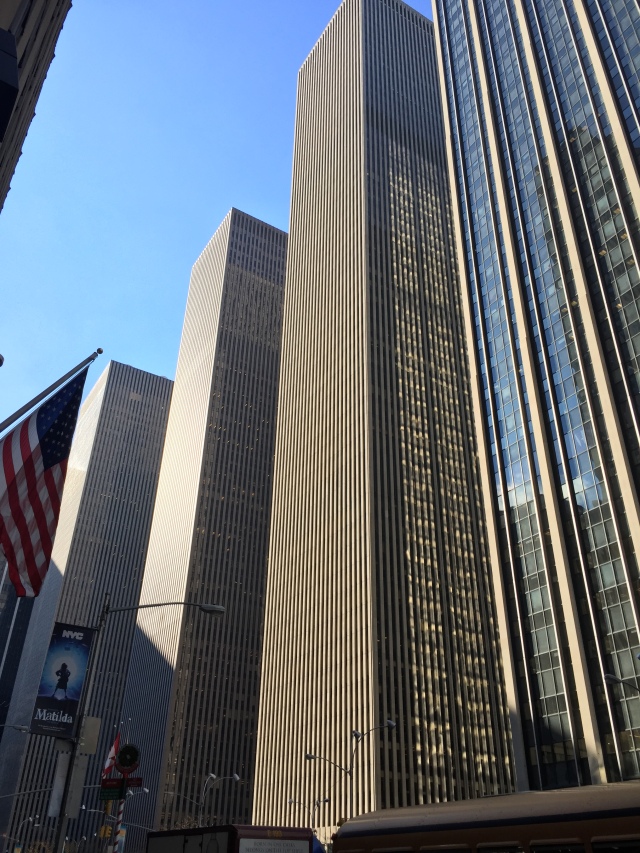 Standing at 1250 Avenue of the Americas and looking across the street to the west side of Sixth Avenue there are four very boxy rectangular skyscrapers—they are an expansion of the center that was built in 1959 and the early 1970s. Heavily criticized as being boring and imposing, they don’t quite reflect the beauty of the original center. This is very much a media center in NYC which includes the Time & Life, McGraw-Hill publishing, and Fox News.
Standing at 1250 Avenue of the Americas and looking across the street to the west side of Sixth Avenue there are four very boxy rectangular skyscrapers—they are an expansion of the center that was built in 1959 and the early 1970s. Heavily criticized as being boring and imposing, they don’t quite reflect the beauty of the original center. This is very much a media center in NYC which includes the Time & Life, McGraw-Hill publishing, and Fox News.

 Time & Life Building (1271 Avenue of the Americas) was constructed for the Time-Life Publishing Company as the first building in the Rockefeller Center Extension across Sixth Avenue from the original Center.
Time & Life Building (1271 Avenue of the Americas) was constructed for the Time-Life Publishing Company as the first building in the Rockefeller Center Extension across Sixth Avenue from the original Center.
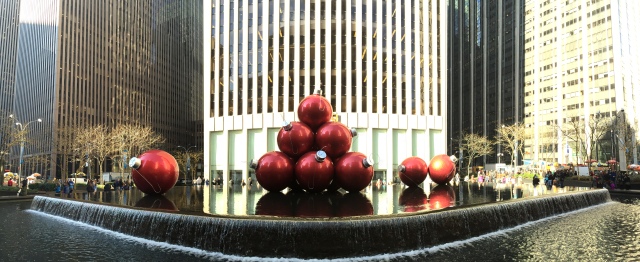 1251 Avenue of the Americas was built in 1967-1971 as the second building in the Rockefeller Center Extension across Sixth Avenue; with the Exxon Oil Company as the main occupant. This 54-storey Exxon building vertically accentuated form rises to the height of 228.5 meters, being the second-tallest building in the whole Rockefeller Center. Facing Sixth Avenue, there is a sunken plaza with large red Christmas-tree ornaments in its reflecting pool, as it does each year.
1251 Avenue of the Americas was built in 1967-1971 as the second building in the Rockefeller Center Extension across Sixth Avenue; with the Exxon Oil Company as the main occupant. This 54-storey Exxon building vertically accentuated form rises to the height of 228.5 meters, being the second-tallest building in the whole Rockefeller Center. Facing Sixth Avenue, there is a sunken plaza with large red Christmas-tree ornaments in its reflecting pool, as it does each year.
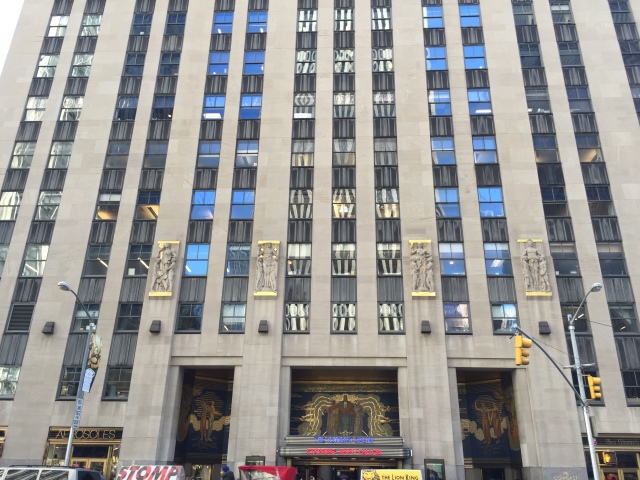 However facing the entrance to 1250 Avenue of the Americas we see the contrast in decorative style with a beautiful mosaic (Intelligence Awakening Mankind, 1933, by Barry Faulkner, American, 1881-1966) in loggia and four allegorical stone carvings (Aspects of Mankind, 1935, by Gaston Lachaise, American, born France, 1882-1935) on sixth-floor façade.
However facing the entrance to 1250 Avenue of the Americas we see the contrast in decorative style with a beautiful mosaic (Intelligence Awakening Mankind, 1933, by Barry Faulkner, American, 1881-1966) in loggia and four allegorical stone carvings (Aspects of Mankind, 1935, by Gaston Lachaise, American, born France, 1882-1935) on sixth-floor façade.
This mosaic of small glass tiles (tesserae) is composed of over one million glass tiles in 250 colors, each hand-cut and hand-set. The work is a narrative concerning the triumph of knowledge over the evil of ignorance (thought will propagate new knowledge and advance civilization). The central figure of thought (intelligence) stands above the world, controlling the action in the mosaic; the two other powerful figures in this piece are spoken words and written words. Other figures symbolize creativity, ideas and intellectual efforts.
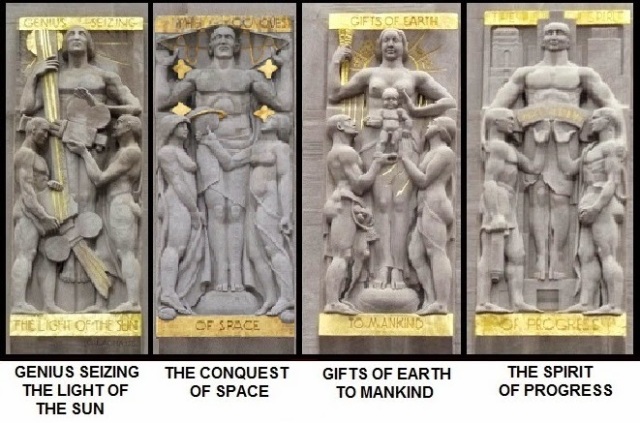 These four allegorical stone carvings express ideal aspects of the development of modern civilization: Genius Seizing the Light of the Sun (the development of electricity and communications), The Conquest of Space, Gifts of Earth to Mankind (an acknowledgment of spirituality), and The Spirit of Progress (a reference to the bond between capitalism and the unions during the building of the Center).(via http://tm01001.blogspot.tw/)
These four allegorical stone carvings express ideal aspects of the development of modern civilization: Genius Seizing the Light of the Sun (the development of electricity and communications), The Conquest of Space, Gifts of Earth to Mankind (an acknowledgment of spirituality), and The Spirit of Progress (a reference to the bond between capitalism and the unions during the building of the Center).(via http://tm01001.blogspot.tw/)
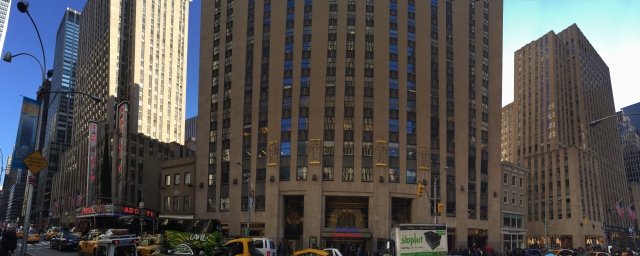 p.s. Two holdout buildings almost stopped the building of Rockefeller Center: As see in the picture, two small, seemingly out-of-place structures abut the north and south corners of the Comcast Building on Sixth Avenue. These buildings exist as a result of two tenants, one a leaseholder, the other the property owner, who refused to sell their rights to Rockefeller during construction. In 1892, a trio of Irishmen leased the property at 1240 Sixth Avenue, and opened Hurley’s (right), a popular pub that operated through prohibition as a speakeasy. (Magnolia Bakery currently occupies the former Hurley’s original tiny townhouse.) Rockefeller bought the building, but their lease trumped his property rights. They offered to sell their rights to him for $250 million (roughly the cost of the entire complex), which he refused. Meanwhile, at 1258 Sixth Avenue on the other corner (left), owner John F. Maxwell simply refused to sell. In the end, Rockefeller was forced to build above and around the two townhouses, the 70-story 30 Rockefeller Plaza remains sandwiched between two three-and-four story structures.
p.s. Two holdout buildings almost stopped the building of Rockefeller Center: As see in the picture, two small, seemingly out-of-place structures abut the north and south corners of the Comcast Building on Sixth Avenue. These buildings exist as a result of two tenants, one a leaseholder, the other the property owner, who refused to sell their rights to Rockefeller during construction. In 1892, a trio of Irishmen leased the property at 1240 Sixth Avenue, and opened Hurley’s (right), a popular pub that operated through prohibition as a speakeasy. (Magnolia Bakery currently occupies the former Hurley’s original tiny townhouse.) Rockefeller bought the building, but their lease trumped his property rights. They offered to sell their rights to him for $250 million (roughly the cost of the entire complex), which he refused. Meanwhile, at 1258 Sixth Avenue on the other corner (left), owner John F. Maxwell simply refused to sell. In the end, Rockefeller was forced to build above and around the two townhouses, the 70-story 30 Rockefeller Plaza remains sandwiched between two three-and-four story structures.
Walk 1/2 block north to 50th St.
 Radio City Music Hall (1260 Avenue of the Americas), designed by Edward Durell Stone, the interior of the theater, by Donald Deskey, was the first building to open in Rockefeller Center on December 27, 1932 and at that time, was the largest indoor theater in the world. This theater, nickname as “Showplace of the Nation," features a stunning Art Deco interior decorated with golden rays and plaster arches. Its interior was declared a city landmark in 1978. Originally Radio City opened as a grand variety house that featured the famous dancers as well as symphonies, movies, news reels and a whole array of various entertainments. Today it is still the largest and most famous theater in America and is primarily used for big name concerts as well as other events such as the Tony Awards, the NFL draft picks (since 2006), and of course the Radio City Christmas Spectacular, a New York Christmas tradition since 1932, featuring the Rockettes.
Radio City Music Hall (1260 Avenue of the Americas), designed by Edward Durell Stone, the interior of the theater, by Donald Deskey, was the first building to open in Rockefeller Center on December 27, 1932 and at that time, was the largest indoor theater in the world. This theater, nickname as “Showplace of the Nation," features a stunning Art Deco interior decorated with golden rays and plaster arches. Its interior was declared a city landmark in 1978. Originally Radio City opened as a grand variety house that featured the famous dancers as well as symphonies, movies, news reels and a whole array of various entertainments. Today it is still the largest and most famous theater in America and is primarily used for big name concerts as well as other events such as the Tony Awards, the NFL draft picks (since 2006), and of course the Radio City Christmas Spectacular, a New York Christmas tradition since 1932, featuring the Rockettes.
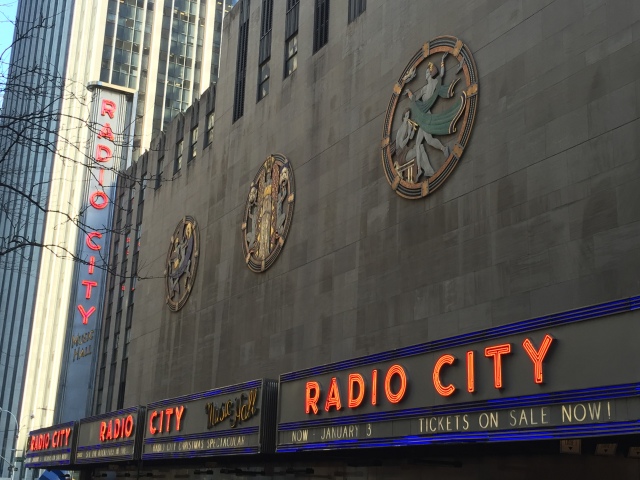 On the 50th St. side of the building are three round, painted metal sculptures representing Dance, Drama and Song (1932). A collaboration between the sculptor and muralist Hildreth M. Meiere (American, 1893-1961) and famed metalworker Oscar Bruno Bach (American, born Germany, 1884-1957), they feature an exciting combination of metals, textures and colors that add playfulness to the plain limestone façade. Meiere first created a series of small, detailed studies; her final gouaches were used by Bach as a blueprint for fabrication in metal and coloration in enamel on a scale never before attempted.
On the 50th St. side of the building are three round, painted metal sculptures representing Dance, Drama and Song (1932). A collaboration between the sculptor and muralist Hildreth M. Meiere (American, 1893-1961) and famed metalworker Oscar Bruno Bach (American, born Germany, 1884-1957), they feature an exciting combination of metals, textures and colors that add playfulness to the plain limestone façade. Meiere first created a series of small, detailed studies; her final gouaches were used by Bach as a blueprint for fabrication in metal and coloration in enamel on a scale never before attempted.
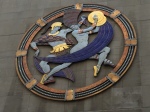 Dance
Dance 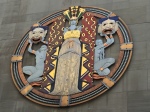 Drama
Drama 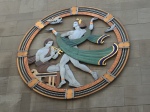 Song These three large stylized decorative plaques represent the theater’s main activities.
Song These three large stylized decorative plaques represent the theater’s main activities.
Walk east on 50th St. towards 5th Ave. to the Top of the Rock entrance, south side of the street.

 Top of the Rock is a six-level observatory atop the Art Deco skyscraper, 30 Rockefeller Plaza. The main entrance to Top of the Rock is located on 50th Street between Fifth and Sixth Avenues. There is also an entrance on the concourse level of 30 Rockefeller Plaza.
Top of the Rock is a six-level observatory atop the Art Deco skyscraper, 30 Rockefeller Plaza. The main entrance to Top of the Rock is located on 50th Street between Fifth and Sixth Avenues. There is also an entrance on the concourse level of 30 Rockefeller Plaza.
Originally opened to the public in 1933, the observation deck at Rockefeller Center was closed to the public in 1986 to provide more space for its Rainbow Room (remember the Sleepless in Seattle?). After $75 million restored and improved makeover, the Top of the Rock Observation Deck reopened to the public in November 2005, offering 360 degree views of the New York City skyline, including fantastic views of Central Park, the Empire State Building, the Chrysler Building, as well as the Hudson and East Rivers.
 In the Grand Atrium Lobby of Top of the Rock, Michael Hammers (Germany, 1965- ) made one of the world’s most breathtaking, beautiful crystal chandeliers, Joie–Crystal Water Fall. It is the largest lighting installation (in 2005) of its kind and an unforgettable sight to see.
In the Grand Atrium Lobby of Top of the Rock, Michael Hammers (Germany, 1965- ) made one of the world’s most breathtaking, beautiful crystal chandeliers, Joie–Crystal Water Fall. It is the largest lighting installation (in 2005) of its kind and an unforgettable sight to see.
The spectacular 35-foot waterfall chandelier soars through three floors over the lobby. Made of 450 free hanging strands and 14,000 crystals it echoes the outline of 30 Rock, the building that is the heart of Rockefeller Center.
Continue towards 5th Ave. to the main plaza and cross the street to the left, between 50th & 51st St.
50 Rockefeller Plaza (Bank of America Building) was originally built as the Associated Press Building and the entrance artwork reflects the building’s original purpose. It is the only building in the Center built to the outer limits of its lot line. 50 Rockefeller Plaza took its shape from the main tenant’s need for a single, undivided, loft-like newsroom as large as the lot could accommodate. At one point, four million feet of transmission wire were embedded in conduits on the building’s fourth floor.
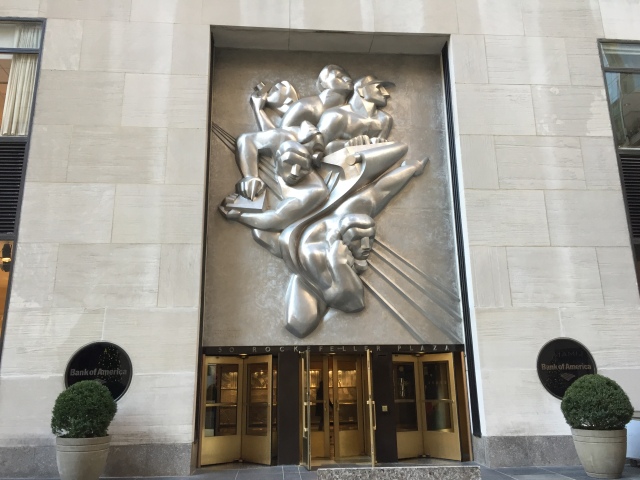 News (1940) by Isamu Noguchi (American, 1904-1988), a giant nine-ton stainless steel bas-relief (at the time it was the largest metal bas-relief in the world), soaring above the main entrance to 50 Rockefeller Plaza, depicts five journalists focused on getting a scoop. AP’s worldwide network is symbolized by diagonal radiating lines extending across the plaque. Intense angles and smooth planes create the fast-paced rhythm and energy of a newsroom. It is the first heroic-sized sculpture ever cast in stainless steel and the only time Noguchi employed stainless steel as an artistic medium.
News (1940) by Isamu Noguchi (American, 1904-1988), a giant nine-ton stainless steel bas-relief (at the time it was the largest metal bas-relief in the world), soaring above the main entrance to 50 Rockefeller Plaza, depicts five journalists focused on getting a scoop. AP’s worldwide network is symbolized by diagonal radiating lines extending across the plaque. Intense angles and smooth planes create the fast-paced rhythm and energy of a newsroom. It is the first heroic-sized sculpture ever cast in stainless steel and the only time Noguchi employed stainless steel as an artistic medium.
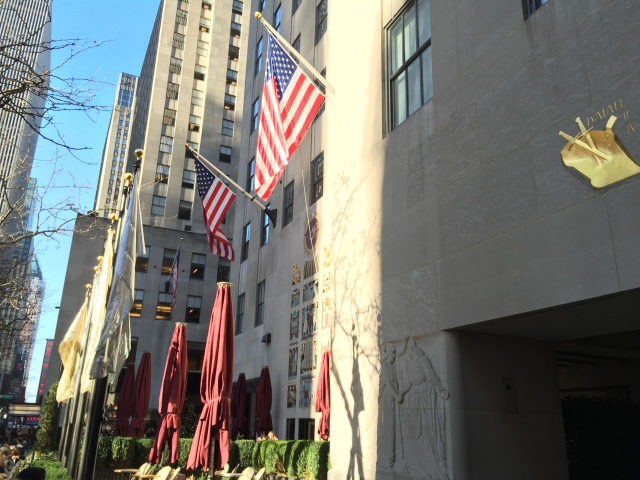 Opposite the Bank of America Building is the west side of the International Building (626-636 Fifth Avenue). On the 29 West 50th St. side of the exterior is a fascinating relief by Lee Lawrie alluding to the international nature of the building. Since Rockefeller Center was built during the Great Depression it as well understood that the commercial complex would hope to draw international businesses as well as American ones, such as steamship companies, and the decorative International Building expresses that intention.
Opposite the Bank of America Building is the west side of the International Building (626-636 Fifth Avenue). On the 29 West 50th St. side of the exterior is a fascinating relief by Lee Lawrie alluding to the international nature of the building. Since Rockefeller Center was built during the Great Depression it as well understood that the commercial complex would hope to draw international businesses as well as American ones, such as steamship companies, and the decorative International Building expresses that intention.
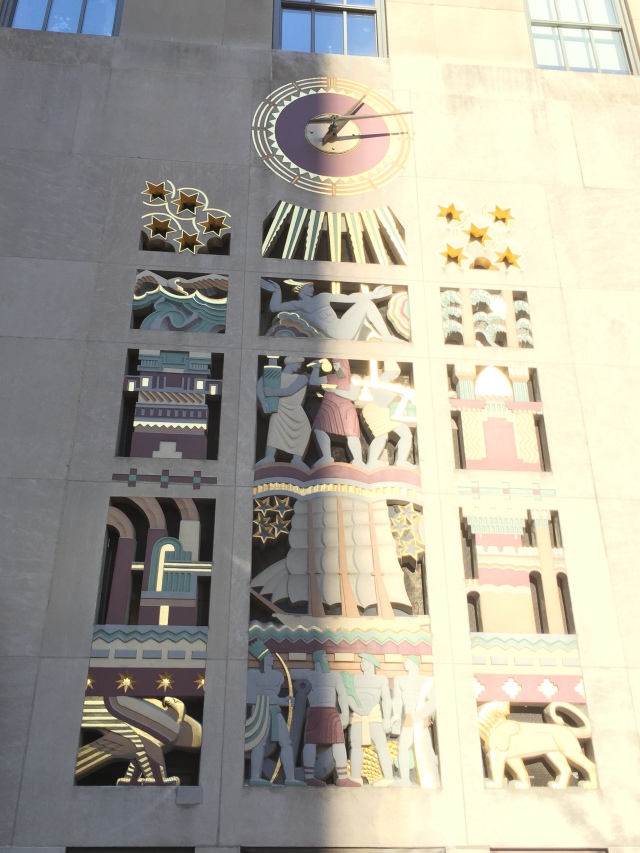 The Story of Mankind (1937) by Lee Lawrie (American, born Germany, 1877-1963) is a massive carved limestone screen divided into fifteen small rectangular spaces that Lawrie termed “hieroglyphs”. It was created to symbolize the purpose of the International Building and to chronicle mankind’s progress: You have a clock at the top that is actually a sun. Just below the sun is Mercury and the sun is shining on Mercury, the god of commerce. To the left and right of Mercury are the four elements: earth, air, water, and fire. Below him are symbols of technology and industry. That is flanked by a mosque, signifying the Old World, and a Mayan or an Aztec temple, symbolizing the New World. Below is a ship of exploration, and the ship is going between the castles of Europe and the industry of America. And below that are figures of the four races that are identified by racial characteristics. To the left and right are the eagle of the New World and the lion of the Old World. So all of this is about the different parts of the world and about world trade because of Rockefeller’s view that through trade you would have international understanding, and all the peoples of the world would come together.
The Story of Mankind (1937) by Lee Lawrie (American, born Germany, 1877-1963) is a massive carved limestone screen divided into fifteen small rectangular spaces that Lawrie termed “hieroglyphs”. It was created to symbolize the purpose of the International Building and to chronicle mankind’s progress: You have a clock at the top that is actually a sun. Just below the sun is Mercury and the sun is shining on Mercury, the god of commerce. To the left and right of Mercury are the four elements: earth, air, water, and fire. Below him are symbols of technology and industry. That is flanked by a mosque, signifying the Old World, and a Mayan or an Aztec temple, symbolizing the New World. Below is a ship of exploration, and the ship is going between the castles of Europe and the industry of America. And below that are figures of the four races that are identified by racial characteristics. To the left and right are the eagle of the New World and the lion of the Old World. So all of this is about the different parts of the world and about world trade because of Rockefeller’s view that through trade you would have international understanding, and all the peoples of the world would come together.
p.s. In order to attract foreign investors and traders to the Center, Rockefeller conceived the idea of providing European nations with their “own" buildings there. All in all, the four outwardly similar low buildings facing Fifth Avenue were designated for that use. The British Empire Building and Palais de France (or Le Maison Francaise), flanking the Channel Gardens, were the first ones. After Italy and Germany also showed interest, the protruding lower wings of the International Building were also planned for similar use as Palazzo D’Italia (626 Fifth Ave.) and Deutsches Haus (636 Fifth Ave.), respectively. However, due to the breaking out of war in Europe the German constituent was canceled and named International Building North instead.
Continue walking east towards 5th Ave. At 5th Ave. make a left.
 The 156.06 m tall International Building is basically a scaled-down version of the GE Building. At its main entrance (630 Fifth Avenue), Atlas (1937) forecourt facing St. Patrick’s Cathedral, is a successful collaboration between two talented artists, Lee Lawrie, who conceived the idea and designed the figure, and Rene Paul Chambellan (American, 1893-1955), who modeled the heroic-sized statue from his sketch.
The 156.06 m tall International Building is basically a scaled-down version of the GE Building. At its main entrance (630 Fifth Avenue), Atlas (1937) forecourt facing St. Patrick’s Cathedral, is a successful collaboration between two talented artists, Lee Lawrie, who conceived the idea and designed the figure, and Rene Paul Chambellan (American, 1893-1955), who modeled the heroic-sized statue from his sketch.
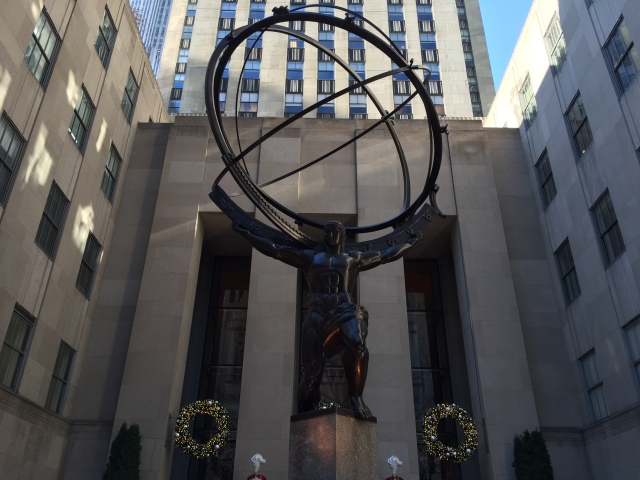 Atlas was a half-man, half-god giant known as a Titan, a famous figure from Greek mythology, who helped lead a war against the Olympic gods. After the Titans’ defeat, Atlas was condemned to carry the world on his shoulders as punishment. In this incredible combination of ancient myth and modern style, the rings of the universe include the zodiacal signs of the constellations and above Atlas’ shoulders are the symbols for the planets of our solar system. Towards the top and to the north is a fleur de lis shaped pointer directing to the North Star.
Atlas was a half-man, half-god giant known as a Titan, a famous figure from Greek mythology, who helped lead a war against the Olympic gods. After the Titans’ defeat, Atlas was condemned to carry the world on his shoulders as punishment. In this incredible combination of ancient myth and modern style, the rings of the universe include the zodiacal signs of the constellations and above Atlas’ shoulders are the symbols for the planets of our solar system. Towards the top and to the north is a fleur de lis shaped pointer directing to the North Star.
Mythological themes are prevalent in the decorative works of Rockefeller Center, again reminding us of the past while we continue striving for the future. 15 feet (4.5 meter) tall bronze statue of Atlas is the largest and one of Rockefeller Center’s greatest Art Deco icons and has even been used on U.S. postage stamps.
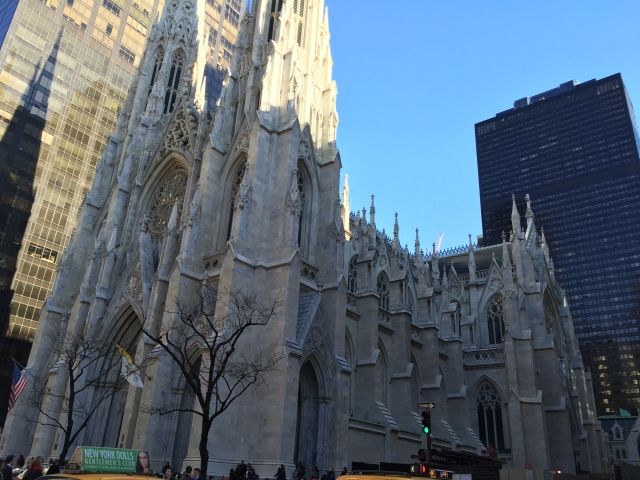 p.s. St. Patrick’s Cathedral is the largest decorated Neo-Gothic-style Catholic cathedral in North America. It is the seat of the archbishop of the Roman Catholic Archdiocese of New York, and a parish church. The cathedral is built of white marble quarried in New York and Massachusetts. Together with its ancillary buildings it occupies one whole city block between Fifth and Madison Avenues, 50th and 51st Streets, facing Rockefeller Center. The cornerstone for this new cathedral was laid on August 15, 1858. The cathedral was designed by James Renwick, Jr. in the Gothic Revival style. Work was begun in 1858 but was halted during the American Civil War, commencing again in 1865. The cathedral was completed in 1878 and was dedicated on May 25, 1879, its huge proportions (332ft long and the spires reach 330ft from street level) dominating the mid-town of that time. The Towers on the West Facade were added in 1888, and an addition on the east, including a Lady Chapel, designed by Charles T. Mathews, began in 1901. The cathedral was renovated between 1927 and 1931, when the great organ was installed, and the sanctuary was enlarged. The cathedral and associated buildings were declared a National Historic Landmark in 1976.
p.s. St. Patrick’s Cathedral is the largest decorated Neo-Gothic-style Catholic cathedral in North America. It is the seat of the archbishop of the Roman Catholic Archdiocese of New York, and a parish church. The cathedral is built of white marble quarried in New York and Massachusetts. Together with its ancillary buildings it occupies one whole city block between Fifth and Madison Avenues, 50th and 51st Streets, facing Rockefeller Center. The cornerstone for this new cathedral was laid on August 15, 1858. The cathedral was designed by James Renwick, Jr. in the Gothic Revival style. Work was begun in 1858 but was halted during the American Civil War, commencing again in 1865. The cathedral was completed in 1878 and was dedicated on May 25, 1879, its huge proportions (332ft long and the spires reach 330ft from street level) dominating the mid-town of that time. The Towers on the West Facade were added in 1888, and an addition on the east, including a Lady Chapel, designed by Charles T. Mathews, began in 1901. The cathedral was renovated between 1927 and 1931, when the great organ was installed, and the sanctuary was enlarged. The cathedral and associated buildings were declared a National Historic Landmark in 1976.
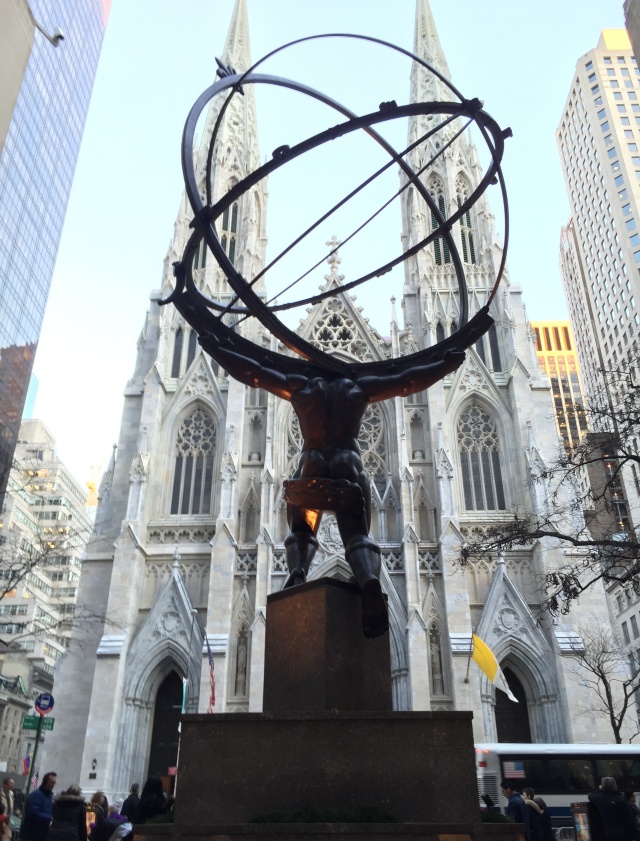 The west front with its twin spires is arguably its best feature. Opposite its west doors in the courtyard of the Rockefeller Center is a statue that appears to show Atlas, which gives an unusual photo moment–with Atlas in the foreground and St. Patrick’s Cathedral in the background. It will likely convince you that no part of the complex’s design was by accident or whimsical. And some have speculated that the giant mythological figure directly across the street from the cathedral was in a way expressing defiance towards the Catholic Church.
The west front with its twin spires is arguably its best feature. Opposite its west doors in the courtyard of the Rockefeller Center is a statue that appears to show Atlas, which gives an unusual photo moment–with Atlas in the foreground and St. Patrick’s Cathedral in the background. It will likely convince you that no part of the complex’s design was by accident or whimsical. And some have speculated that the giant mythological figure directly across the street from the cathedral was in a way expressing defiance towards the Catholic Church.
Turn right and walk south across 50th St.
 The British Empire Building (620 Fifth Avenue)/La Maison Francaise (610 Fifth Avenue), these two buildings both offer intriguing decoration adorning their facades.
The British Empire Building (620 Fifth Avenue)/La Maison Francaise (610 Fifth Avenue), these two buildings both offer intriguing decoration adorning their facades.
 Above 620 Fifth Avenue Entrance is Industries of the British Empire (1933) by Carl Paul Jennewein (American, born Germany, 1890-1978). The nine gilded allegorical figures on this large bronze panel represent industries that were once considered major sources of income for the British. Depicted as beautiful, unemotional and idealized, they include Coal, Fish, Salt, Tobacco and Sugar. Australia is symbolized by Wool, Canada by Wheat and Africa by Cotton. A stylized sculpted sun is symbolic of the saying, “The sun never sets on the British Empire." Above the gilded panel is a polychrome and gilded limestone carving of The British Coat of Arms. The sculpture was designed by Carl Paul Jennewein and carved at the Piccirilli Studio.
Above 620 Fifth Avenue Entrance is Industries of the British Empire (1933) by Carl Paul Jennewein (American, born Germany, 1890-1978). The nine gilded allegorical figures on this large bronze panel represent industries that were once considered major sources of income for the British. Depicted as beautiful, unemotional and idealized, they include Coal, Fish, Salt, Tobacco and Sugar. Australia is symbolized by Wool, Canada by Wheat and Africa by Cotton. A stylized sculpted sun is symbolic of the saying, “The sun never sets on the British Empire." Above the gilded panel is a polychrome and gilded limestone carving of The British Coat of Arms. The sculpture was designed by Carl Paul Jennewein and carved at the Piccirilli Studio.
Motifs from the Coats of Arms of The British Isles (1933), on Fifth Avenue façade sixth-floor spandrels of 620 Fifth Avenue, is Rene Paul Chambellan’s (American, 1893-1955) series of carvings. Chambellan borrowed motifs from the coats of arms of England, Scotland, Wales and Ireland—the four countries that make up the British Isles. The carvings help publicize the government of Great Britain, the building’s primary tenant at the time. They symbolize what is royally, historically or mythologically significant in each country: Wales is a mighty dragon; England is a lion and large Tudor rose; Scotland is a unicorn and outsized thistle; Ireland is an elegant stag with harp and shamrock.
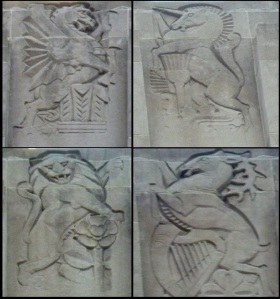 (via http://tm01001.blogspot.tw)
(via http://tm01001.blogspot.tw)
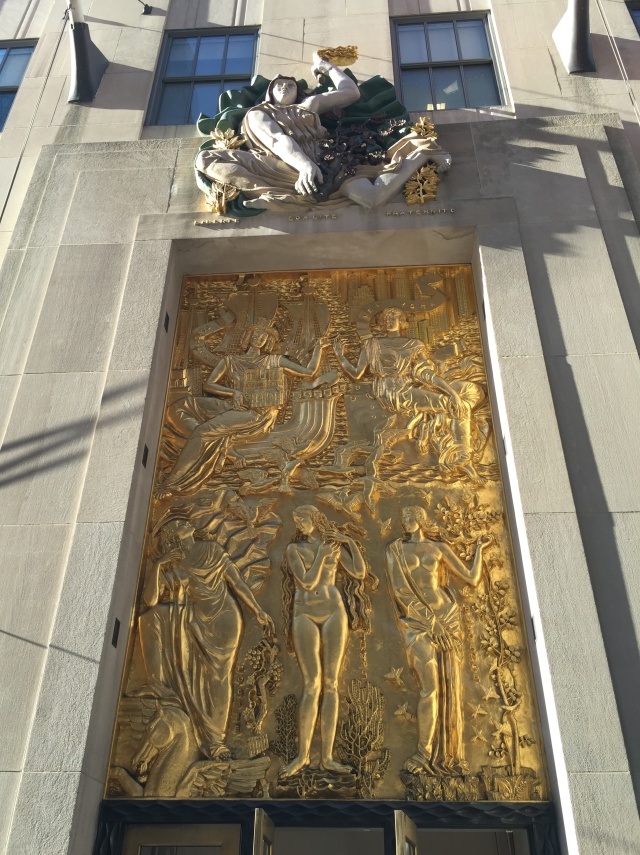 Sparkling above the main entrance to La Maison Française, Friendship between America and France (1934) by Alfred Janniot (French, 1889-1969) reads in narrative form from top to bottom. The top two heroic-size females holding hands symbolize the alliance between Paris and New York, while the three females below represent three Graces: Poetry, Beauty and Elegance—the cultural exchange between the two nations. The winged horse of mythology symbolizes inspiration and imagination. Unlike much of the art found at Rockefeller Center, this piece cannot be considered Art Deco, due to its classicism and vibrant ornamentation. Perched above the entrance of La Maison Francaise, Gallic Freedom (1934) by Alfred Janniot, this massive, majestic figure is symbolic of French freedom as she proclaims Liberte, Egalite, Fraternite (Liberty, Equality, Fraternity) to the world. Her gilded Torch of Freedom evokes the flame of revolution and its triumph. The carving’s strong details, twisted pose and deep undercuts are typical of Janniot’s style. Gallic Freedom references the energy and patriotism of the famed 1830s painting Liberty Leading the People by Eugene Delacroix.
Sparkling above the main entrance to La Maison Française, Friendship between America and France (1934) by Alfred Janniot (French, 1889-1969) reads in narrative form from top to bottom. The top two heroic-size females holding hands symbolize the alliance between Paris and New York, while the three females below represent three Graces: Poetry, Beauty and Elegance—the cultural exchange between the two nations. The winged horse of mythology symbolizes inspiration and imagination. Unlike much of the art found at Rockefeller Center, this piece cannot be considered Art Deco, due to its classicism and vibrant ornamentation. Perched above the entrance of La Maison Francaise, Gallic Freedom (1934) by Alfred Janniot, this massive, majestic figure is symbolic of French freedom as she proclaims Liberte, Egalite, Fraternite (Liberty, Equality, Fraternity) to the world. Her gilded Torch of Freedom evokes the flame of revolution and its triumph. The carving’s strong details, twisted pose and deep undercuts are typical of Janniot’s style. Gallic Freedom references the energy and patriotism of the famed 1830s painting Liberty Leading the People by Eugene Delacroix.
Pageant of French History (1934), on Sixth floor spandrels of the 610 Fifth Avenue Façade, is also Rene Paul Chambellan’s work. Symbols from four significant events in France’s history illustrate the themes of Pageant of French History. The Roman Period features a sword with the letters S.P.Q.R., an abbreviation for The Senate and the People of Rome. Five spears symbolize New United France, while a crown atop a torch illustrates Absolute Monarchy Established under Louis XIV. The fourth spandrel is a tribute to the French Republic, with the large letters RF and three symbols for unity, freedom and victory.
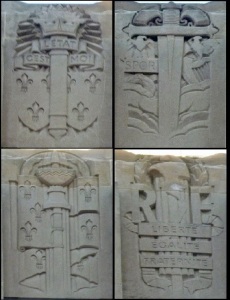 (via http://tm01001.blogspot.tw)
(via http://tm01001.blogspot.tw)
Walk back to the promenade in between the British and French buildings and turn left.
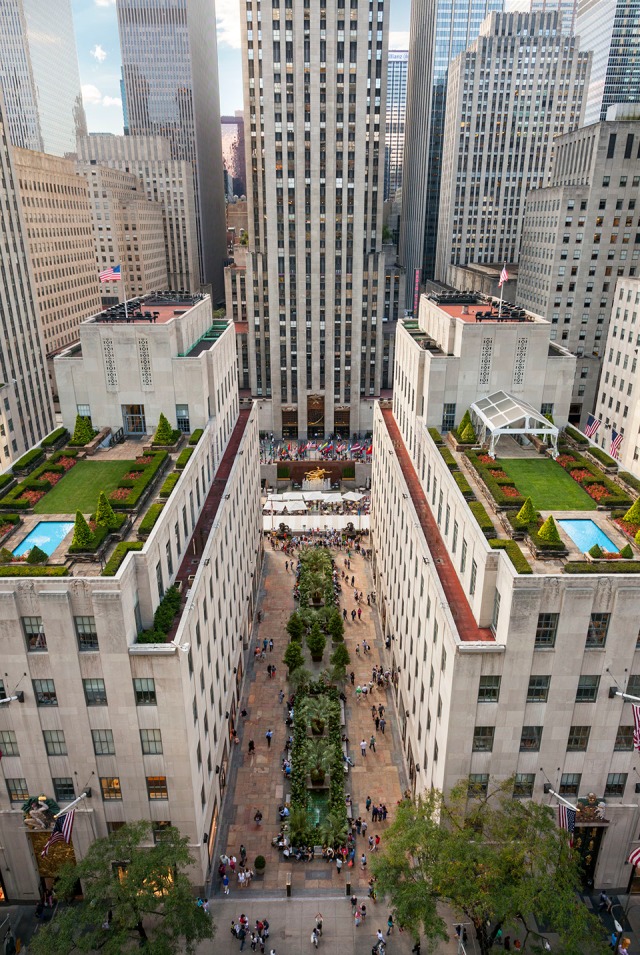 The famous promenade known as The Channel Gardens (flanked by The English Building and La Maison Francaise, hence the name). (via http://kensmithworkshop.com/)
The famous promenade known as The Channel Gardens (flanked by The English Building and La Maison Francaise, hence the name). (via http://kensmithworkshop.com/)
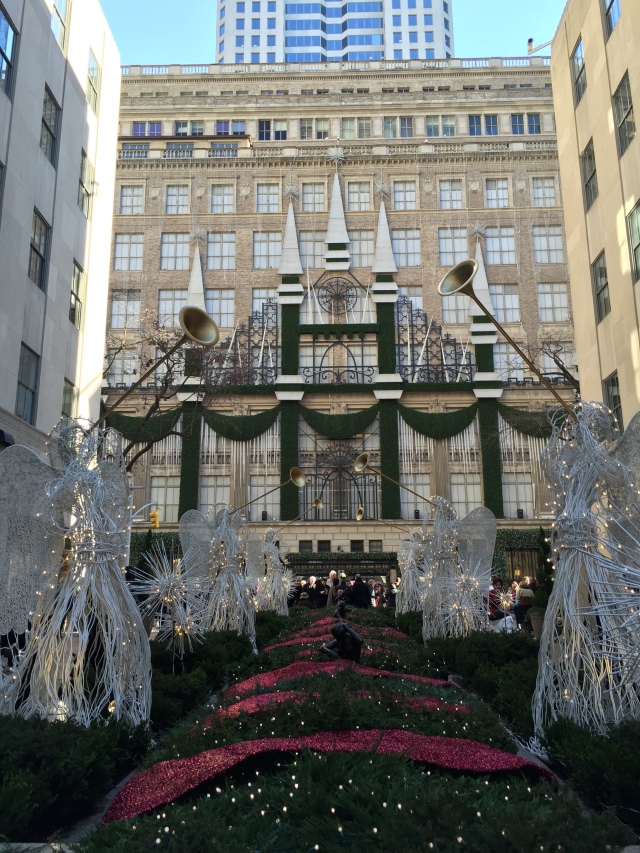 The promenade slopes gently from the modestly scaled 5th Avenue frontage towards the heart of the main plaza (sunken plaza), encouraging pedestrians to follow the complex-wide theme of humanity’s progress towards new frontier path. The center of the walkway are granite pools and fountains, which are surrounded by seasonal floral displays.
The promenade slopes gently from the modestly scaled 5th Avenue frontage towards the heart of the main plaza (sunken plaza), encouraging pedestrians to follow the complex-wide theme of humanity’s progress towards new frontier path. The center of the walkway are granite pools and fountains, which are surrounded by seasonal floral displays.
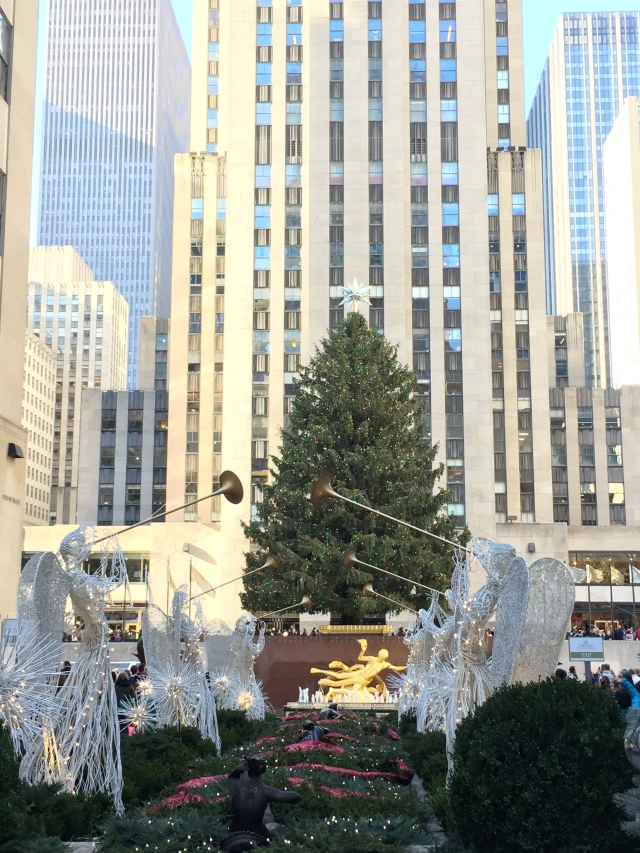 At Christmas time, of course, the center’s enormous lighted Christmas Tree, placed above the fire-carrying Prometheus on Rockefeller Plaza, makes the 200-foot/ three-block-long private walkway, the world’s most spectacular and popular hearth.
At Christmas time, of course, the center’s enormous lighted Christmas Tree, placed above the fire-carrying Prometheus on Rockefeller Plaza, makes the 200-foot/ three-block-long private walkway, the world’s most spectacular and popular hearth.
p.s. In winter, the Channel Gardens fountains are turned off and the Center is decorated for the Christmas holidays. The decorations varied for many years until 1954, when Valerie Clarebout (American, born England, 1908-1982) introduced twelve wire-sculpture Christmas Angels which, a few years later, became permanent fixtures at Christmastime. Each figure holds six-foot-long brass trumpets angled toward the world-famous Christmas Tree at Rockefeller Center. Both the figures and sparkling wire snowflakes glitter from thousands of tiny lights.
 The flagstone promenade is lined with consistent retail frontages and the spatial relationships are cozy despite the vertiginous 30 Rockefeller Center tower. Like many other decorations around the center (depend on the day or season), usually you will see the flags of all the countries that are members of the United Nations. Sometimes instead the state flags of the U.S. are flying. On patriotic holidays such as July 4th the plaza flies American flags, and during Christmas season the flags are all shimmering gold, silver, red and green.
The flagstone promenade is lined with consistent retail frontages and the spatial relationships are cozy despite the vertiginous 30 Rockefeller Center tower. Like many other decorations around the center (depend on the day or season), usually you will see the flags of all the countries that are members of the United Nations. Sometimes instead the state flags of the U.S. are flying. On patriotic holidays such as July 4th the plaza flies American flags, and during Christmas season the flags are all shimmering gold, silver, red and green.
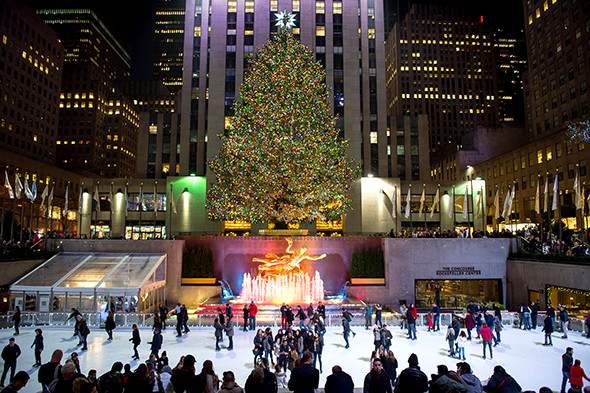 Directly ahead is the tallest building and main centerpiece of Rockefeller Center—the Comcast Building, also known as 30 Rock. In front of the main entrance are the Lower Plaza and the famed 18-foot high gilded statue of Prometheus. By 1940 Radio City, which became known as Rockefeller Center, consisted of 14 buildings, located around a central sunken plaza, the Lower Plaza. The Lower Plaza is where you’ll find the city’s most famous ice skating rink from October through March. In the spring and summer it serves as an outdoor cafe. The backdrop for the statue at this view point will depend on the season. From late November to early January the world famous Rockefeller Christmas Tree, one of NYC’s most popular traditions, stands directly behind Prometheus.
Directly ahead is the tallest building and main centerpiece of Rockefeller Center—the Comcast Building, also known as 30 Rock. In front of the main entrance are the Lower Plaza and the famed 18-foot high gilded statue of Prometheus. By 1940 Radio City, which became known as Rockefeller Center, consisted of 14 buildings, located around a central sunken plaza, the Lower Plaza. The Lower Plaza is where you’ll find the city’s most famous ice skating rink from October through March. In the spring and summer it serves as an outdoor cafe. The backdrop for the statue at this view point will depend on the season. From late November to early January the world famous Rockefeller Christmas Tree, one of NYC’s most popular traditions, stands directly behind Prometheus.
 Prometheus (1934) by Paul Manship is considered to be among the top four most famous statues in America along with Mount Rushmore, the statue of Abraham Lincoln in Washington D.C. and the Statue of Liberty. Prometheus was a Titan in Greek mythology who defied Zeus by giving mankind the gift of fire. Here we see Prometheus descending from the heavens, as suggested by the astrological symbols surrounding him, with a ball of fire in his hand. Its central theme is best stated by the quote that’s carved in the red granite wall behind him, taken from the sixth-century B.C. Greek dramatist Aeschylus: “Prometheus, Teacher in Every Art, Brought the Fire That Hath Proved to Mortals a Means to Mighty Ends."
Prometheus (1934) by Paul Manship is considered to be among the top four most famous statues in America along with Mount Rushmore, the statue of Abraham Lincoln in Washington D.C. and the Statue of Liberty. Prometheus was a Titan in Greek mythology who defied Zeus by giving mankind the gift of fire. Here we see Prometheus descending from the heavens, as suggested by the astrological symbols surrounding him, with a ball of fire in his hand. Its central theme is best stated by the quote that’s carved in the red granite wall behind him, taken from the sixth-century B.C. Greek dramatist Aeschylus: “Prometheus, Teacher in Every Art, Brought the Fire That Hath Proved to Mortals a Means to Mighty Ends."
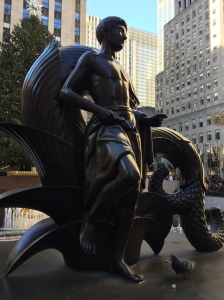
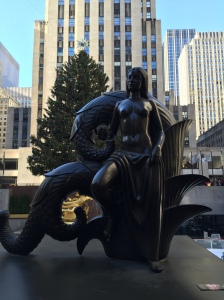 Paul Manship (American, 1885-1966) created these heroic-sized Mankind Figures in 1936 to flank the golden Titan Prometheus. At the time they were gilded and stood on granite shelves. Manship wasn’t happy with the installation and had the figures placed on others sites, but eventually they were removed and stored on the roof garden of the British Empire Building until 1983, when they were rescued from oblivion, restored, and given a traditional brown patina. They were first moved to the skating rink and then, in 2001, moved to their current location near the staircase to the Lower Plaza, announcing Prometheus.
Paul Manship (American, 1885-1966) created these heroic-sized Mankind Figures in 1936 to flank the golden Titan Prometheus. At the time they were gilded and stood on granite shelves. Manship wasn’t happy with the installation and had the figures placed on others sites, but eventually they were removed and stored on the roof garden of the British Empire Building until 1983, when they were rescued from oblivion, restored, and given a traditional brown patina. They were first moved to the skating rink and then, in 2001, moved to their current location near the staircase to the Lower Plaza, announcing Prometheus.
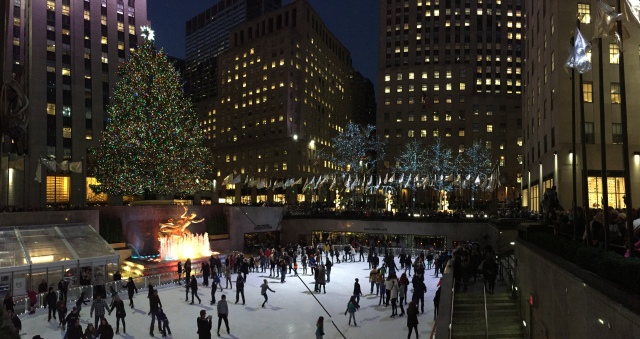 Walk down the spiral staircase, then ahead towards the Lower Concourse of the Comcast Building.
Walk down the spiral staircase, then ahead towards the Lower Concourse of the Comcast Building.
p.s. It was only at Christmas Day in 1936 that the ice skating rink was finally installed and the popular Center activity of ice skating began.
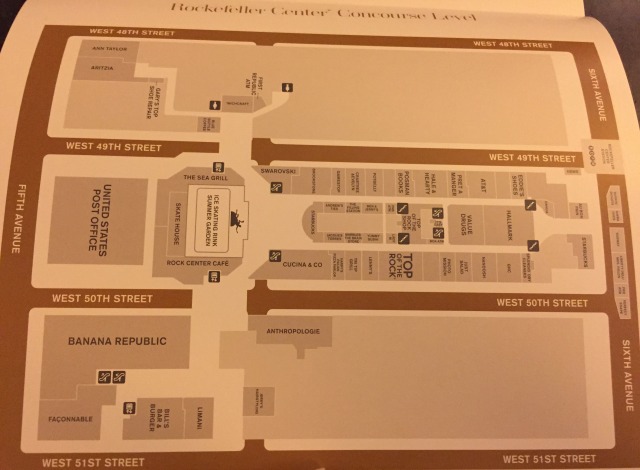 Lower Concourse, located underneath Rockefeller Center, is New York’s largest underground city. The Lower Concourse features retail shops, fast food, fine dining, and an ice rink. It is more than two miles of underground passageways that connect all 19 buildings, as well as the New York subway.
Lower Concourse, located underneath Rockefeller Center, is New York’s largest underground city. The Lower Concourse features retail shops, fast food, fine dining, and an ice rink. It is more than two miles of underground passageways that connect all 19 buildings, as well as the New York subway.
Go up one level to the main lobby.
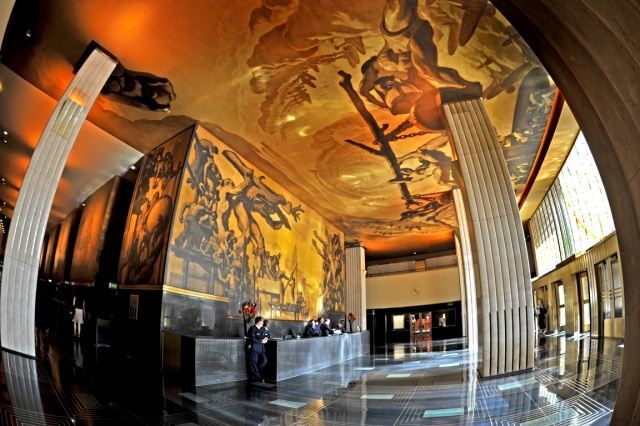 Naturally the main entrance to Rockefeller Center’s centerpiece building reminds its visitors of the intentions and visions of the time with impossible to ignore murals and frescoes. The all surrounding artwork is by Spanish artist Jose Maria Sert (Spanish, 1876-1945) who was commissioned to paint this mural after the Rockefeller fired Diego Rivera. He used powerful imagery to depict scenes of the past while striving through industry for a better future. (via Wikipedia)
Naturally the main entrance to Rockefeller Center’s centerpiece building reminds its visitors of the intentions and visions of the time with impossible to ignore murals and frescoes. The all surrounding artwork is by Spanish artist Jose Maria Sert (Spanish, 1876-1945) who was commissioned to paint this mural after the Rockefeller fired Diego Rivera. He used powerful imagery to depict scenes of the past while striving through industry for a better future. (via Wikipedia)
p.s. The original lobby painting was commissioned to the famous artist Diego Rivera (Mexico, 1886-1957), who had strong political feelings. His final work “Man at the Crossroads" differed somewhat from the original plan he submitted and was clearly anti-capitalist. It depicted scenes of protesters marching with red flags, and even included a portrait of Lenin. The Rockefeller Foundation would have kept the painting had Rivera been willing to paint over the more controversial portions. But Rivera said he would rather see the painting destroyed than to alter it. So Rivera got his wish.
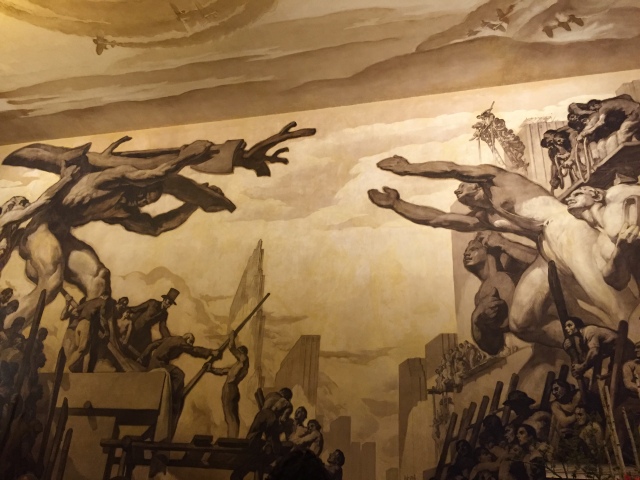 The mural directly behind the information desk opposite the plaza-side entrance (west wall of the Grand Lobby of the Comcast Building) is called American Progress (1937) and depicts the development of America through the unity of brain and brawn. Containing three Graces symbolize man’s intellectual activity, Abraham Lincoln, Mahatma Gandhi, and Ralph Waldo Emerson, while Titans and men working represent men of action.
The mural directly behind the information desk opposite the plaza-side entrance (west wall of the Grand Lobby of the Comcast Building) is called American Progress (1937) and depicts the development of America through the unity of brain and brawn. Containing three Graces symbolize man’s intellectual activity, Abraham Lincoln, Mahatma Gandhi, and Ralph Waldo Emerson, while Titans and men working represent men of action.
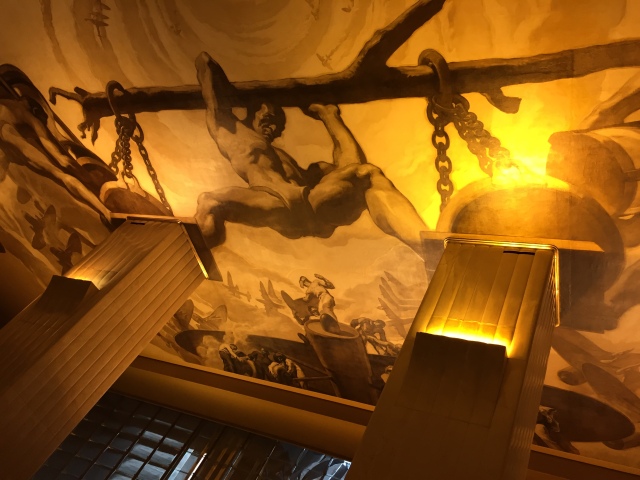 The main lobby’s dramatic ceiling mural Time (1941) depicts heroic-sized, Titans who symbolize the three aspects of time: Past, Present and Future. By exposing their bodies and making them muscular, Sert implies that time is both part of nature and is powerful. The Titans are portrayed evaluating man’s achievements, with the mural integrating the architecture into the subject matter—both the scales and the Titans’ feet are shown resting on actual marble columns that support the lobby ceiling, creating a panoramic vision of the weighing of man’s deeds.
The main lobby’s dramatic ceiling mural Time (1941) depicts heroic-sized, Titans who symbolize the three aspects of time: Past, Present and Future. By exposing their bodies and making them muscular, Sert implies that time is both part of nature and is powerful. The Titans are portrayed evaluating man’s achievements, with the mural integrating the architecture into the subject matter—both the scales and the Titans’ feet are shown resting on actual marble columns that support the lobby ceiling, creating a panoramic vision of the weighing of man’s deeds.
p.s. It’s said the giants atop the pillars always face you, no matter where you move through the lobby.
Walk out of the main entrance into the plaza and turn around to face the Comcast Building—the heart of Rockefeller Center.
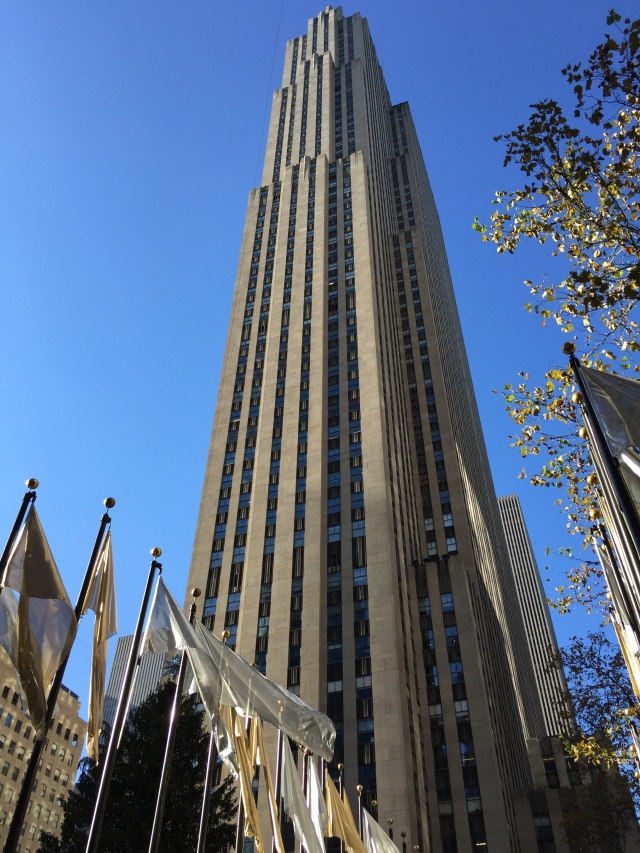 30 Rockefeller Plaza (Comcast Building at 1250 Avenue of the Americas) was originally built as the RCA Building as its original intention has always been to broadcast radio and television; in 1988 renamed the GE Building (General Electric); in 2015 became the Comcast Building. It is 850 ft. (259.1 m) of art deco splendor spread out over 70-stories of shops, offices, broadcasting studios, and more. Raymond Hood’s RCA building (popularly known as 30 Rock) dominates Rockefeller Center. It is the 39th tallest building in the United States and 14th tallest in New York City. Its form is subtlety modulated by stepped setbacks and fully clad in gray Indiana limestone as are of the similarly styled though smaller 13 other buildings in the original complex. Despite its bulk, the width of the tower’s slab shaft is proportionally small. Its flat roof (instead of a spire, making it unusual for an Art Deco Building) has been home of the Center’s observation deck, the Top of the Rock since 1933.
30 Rockefeller Plaza (Comcast Building at 1250 Avenue of the Americas) was originally built as the RCA Building as its original intention has always been to broadcast radio and television; in 1988 renamed the GE Building (General Electric); in 2015 became the Comcast Building. It is 850 ft. (259.1 m) of art deco splendor spread out over 70-stories of shops, offices, broadcasting studios, and more. Raymond Hood’s RCA building (popularly known as 30 Rock) dominates Rockefeller Center. It is the 39th tallest building in the United States and 14th tallest in New York City. Its form is subtlety modulated by stepped setbacks and fully clad in gray Indiana limestone as are of the similarly styled though smaller 13 other buildings in the original complex. Despite its bulk, the width of the tower’s slab shaft is proportionally small. Its flat roof (instead of a spire, making it unusual for an Art Deco Building) has been home of the Center’s observation deck, the Top of the Rock since 1933.
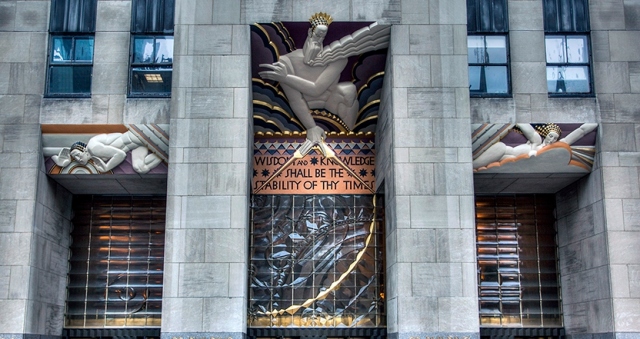 Bold, streamlined and angular, these Art Deco carvings extend the central decoration across the whole entrance. They herald the advent of radio (sound) and the motion picture industry and television (light), two industries that were achieving global significance as the Center was being built.
Bold, streamlined and angular, these Art Deco carvings extend the central decoration across the whole entrance. They herald the advent of radio (sound) and the motion picture industry and television (light), two industries that were achieving global significance as the Center was being built.
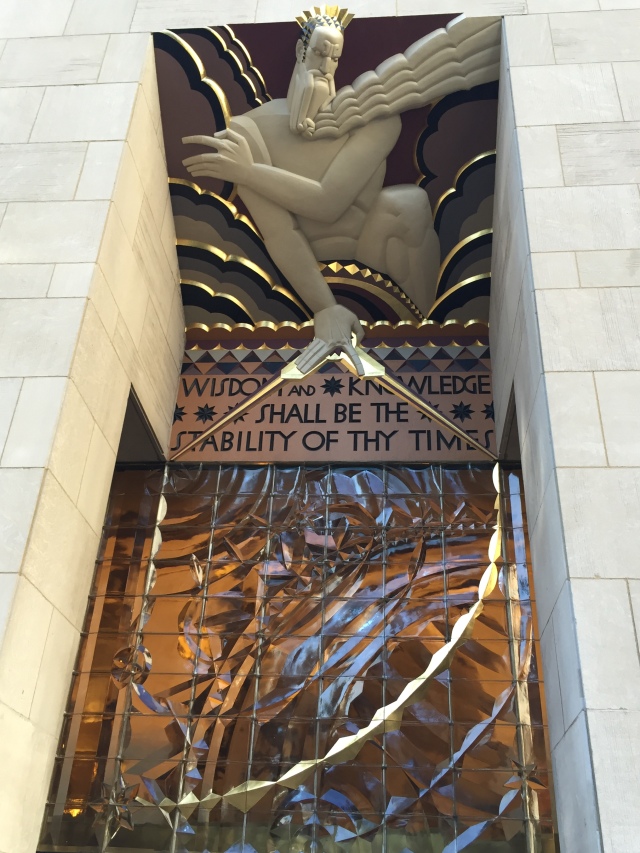 The impressive and commanding bas-relief above the main entrance by Lee Lawrie depicts the figure of Wisdom (1933) spreading a compass over a beautiful glass screen made from 240 blocks of glass from the esteemed Corning Co. The message sculpted below, “Wisdom and Knowledge shall be the stability of thy times” is excerpt from the Bible, Isaiah 33:6.
The impressive and commanding bas-relief above the main entrance by Lee Lawrie depicts the figure of Wisdom (1933) spreading a compass over a beautiful glass screen made from 240 blocks of glass from the esteemed Corning Co. The message sculpted below, “Wisdom and Knowledge shall be the stability of thy times” is excerpt from the Bible, Isaiah 33:6.
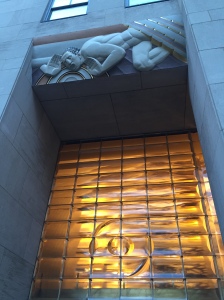
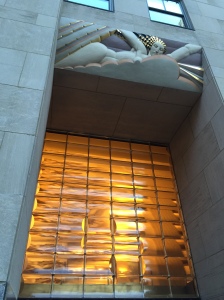 Sound appears alert and animated, his voice depicted as circles emanating from his mouth, while Light emerges from cosmic clouds, raising her arms to send electrical images through the air.
Sound appears alert and animated, his voice depicted as circles emanating from his mouth, while Light emerges from cosmic clouds, raising her arms to send electrical images through the air.
It’s time to look at the spectacular Christmas Tree!
83rd Rockefeller Center Tree Lighting (Dec. 2, 2015-Jan. 7, 2016) For over eight decades, the Christmas Tree at Rockefeller Center and the holiday decorations adorning and surrounding have stood as a holiday beacon for New Yorkers and visitors alike. People wait in line to ice skate in its shadow.
From the beginning, the Tree was a gathering place and reflection of what was happening in the world around it. Even before the first formal tree went up (1933), workers lined up beneath a Christmas tree on the Rockefeller Plaza construction site to collect their paychecks during the height of the Great Depression (1931). Today, more than half a million people pass by the Tree very day, making Rockefeller Center the epicenter of New York City’s holiday celebrations.
 p.s. Though the tree will be put up sometime in early to mid-November, it will not be lit until the Wednesday after Thanksgiving. Once the tree is lit, it is illuminated from 5:30am until 11:30pm daily, except for Christmas Day, when it is lit for 24 hours, and New Year’s Eve, when the lights are turned off at 9pm. Also, after 1963, Christmas Tree stays up until at least January 6 which is the Christian Feast of the Epiphany—the official end to the Christmas Season.
p.s. Though the tree will be put up sometime in early to mid-November, it will not be lit until the Wednesday after Thanksgiving. Once the tree is lit, it is illuminated from 5:30am until 11:30pm daily, except for Christmas Day, when it is lit for 24 hours, and New Year’s Eve, when the lights are turned off at 9pm. Also, after 1963, Christmas Tree stays up until at least January 6 which is the Christian Feast of the Epiphany—the official end to the Christmas Season.
 The holiday season officially began on December 2, 2015 at 7pm with the lighting of the Rockefeller Center Christmas Tree. The tree will be lit until January 7, 2016 at 8pm. This year, thousands of people witnessed the lighting of 45,000 multi-colored-that’s five miles of wires, energy efficient LED bulbs on the 80-year-old Norway Spruce (78 feet tall, 47 feet in diameter and weighs about 10 tons) which is topped with a spectacular Swarovski Crystal Star.
The holiday season officially began on December 2, 2015 at 7pm with the lighting of the Rockefeller Center Christmas Tree. The tree will be lit until January 7, 2016 at 8pm. This year, thousands of people witnessed the lighting of 45,000 multi-colored-that’s five miles of wires, energy efficient LED bulbs on the 80-year-old Norway Spruce (78 feet tall, 47 feet in diameter and weighs about 10 tons) which is topped with a spectacular Swarovski Crystal Star.
Interesting Facts about Rockefeller Center Christmas Tree:
1. Rockefeller Center’s very first tree was actually a grassroots effort.
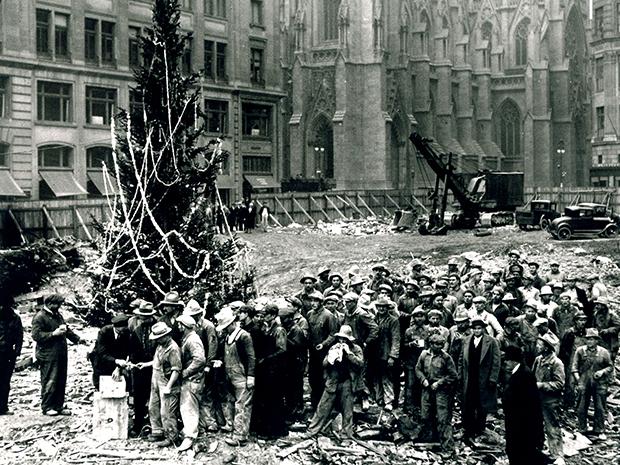 The first-ever tree was erected in 1931 (even preceded Rockefeller Center itself!) by a group of Depression-era construction workers who were hired to build the Rockefeller Center complex. The group decorated a 20-foot-tall spruce with handmade garlands made from the tinfoil ends of blasting caps used in the excavation, and lined up beside it on Christmas Eve to get their paychecks. (via https://www.rockefellercenter.com/)
The first-ever tree was erected in 1931 (even preceded Rockefeller Center itself!) by a group of Depression-era construction workers who were hired to build the Rockefeller Center complex. The group decorated a 20-foot-tall spruce with handmade garlands made from the tinfoil ends of blasting caps used in the excavation, and lined up beside it on Christmas Eve to get their paychecks. (via https://www.rockefellercenter.com/)
2. Two years later, they made it official. The construction of this opulent new tower, the biggest private building project in New York City at that time, became a beacon of hope in the early years of the Great Depression. So for Christmas 1933, the first holiday after Rock Center was completed, the company arranged an official tree-lighting ceremony. A 40-foot-tall tree was strung up with 700 electric lights, and the shebang was broadcast to the nation—on NBC Radio, of course.
3. With a few exceptions, the tree’s always been tricked out with multi-colored lights. In 1942, instead of a single tree, three trees were erected in the plaza—one was trimmed in red, one in white, and one in blue to honor World War II troops. The trees were never lit, due to wartime blackout rules; ditto the following two years until the end of the war.
4. As the tradition grew, the job of finding the tree became a year-round pursuit. David P. Murbach, manager of the gardens division of Rockefeller Center, was in charge of finding the tree for nearly three decades before his death in 2010. He searched all year long, often renting helicopters to explore surrounding states and search for the perfect specimen. “You want personality: there’s density, a height and a width that we need," he once said. “But some trees have a way of holding their branches. I don’t know what else to call it but character." (The tree must be at least 65 feet tall and 35 feet wide, but the preferred height is usually between 75 and 90 feet tall and proportionally wide. The tallest Rockefeller Tree in history was in 1999—a 100-foot tree from Killingworth, Connecticut.)
p.s. There is no monetary compensation offered for the tree if yours is selected. It is a donation and considered an honor to have your tree as the official Rockefeller Center Christmas Tree.
5. The task of transporting it will blow your mind. Over the years, the firs have come from Pennsylvania, New Hampshire, even Canada. After it’s chopped down, most trees are driven through the streets of Manhattan on a custom-built trailer; others are floated on a barge down the Hudson River. In 1998, when the 74-foot-tall Norway spruce needed a ride from Richfield, Ohio, it was actually flown in on an Antonov An-124 Ruslan, the world’s largest cargo plane.
p.s. The first tree from outside of the United States was from Ottawa, Canada, and was donated in honor of the Centennial of its Confederation (1966).
6. Its star is made of shatterproof glass—and lots of crystals.
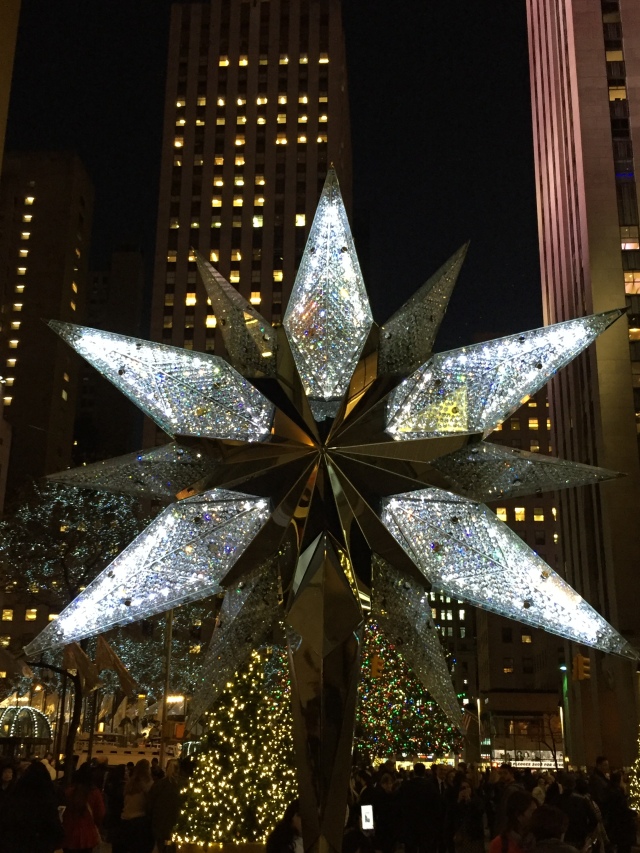 It wouldn’t be Christmas without a little bling: The tree is only decorated by lights and a star. Since 2004, the Swarovski Star has twinkled atop the Rockefeller Center Christmas Tree (2015 marks the star’s 12th year on the tree). Comprised of over 25,000 crystals and sparkling with one million facets, the Star measures 9.5 feet in diameter, 1.5 feet deep, and is nearly 600 pounds. It was created and assembled at Michael Hammers Studios in Germany.
It wouldn’t be Christmas without a little bling: The tree is only decorated by lights and a star. Since 2004, the Swarovski Star has twinkled atop the Rockefeller Center Christmas Tree (2015 marks the star’s 12th year on the tree). Comprised of over 25,000 crystals and sparkling with one million facets, the Star measures 9.5 feet in diameter, 1.5 feet deep, and is nearly 600 pounds. It was created and assembled at Michael Hammers Studios in Germany.
7. The tree got major upgrade for energy efficiency in 2007. Stringing a giant evergreen with lights was never a great move for the environment. So eight years ago, the incandescent bulbs were replaced with LED lights, a move that saved 1200 kwH per day. To put that in perspective: It’s estimated that a family in a 2000-square-foot home would use 1200 kwH to power their household for an entire month. Solar panels, stationed on top a building in Rockefeller Center, power the LEDs.
8. Tree can be nominated by their owners. While the search for the perfect tree is ongoing, individuals can also submit their own trees for consideration—and that’s how the 2015 Rock Center Christmas tree was found. Back in the spring, Albert Asendorf of Gardiner, New York, sent in photos of his 78-foot spruce, the centerpiece of the family’s front yard for more than 50 years. Asendorf and his partner, Nancy Puchalski, were worried that the oversized tree would fall onto the house. “It was almost a goner," Asendorf told CBS. “We were just going to cut it up and get rid of it somehow, use it for firewood." But that call would have been a tough one to make—the tree had stood in the yard since Asendorf’s father bought the place in 1957, and three generations of the family had played in its branches. So instead of cutting it down, they submitted the tree on a whim. After the submission caught his eye, today’s head gardener, Erik Pauze, visited Asendorf’s tree and climbed nearly to the top to check things out. “It had a great shape, nice branches, and when I came up and looked for it, the sun was shining right on it so it made it even more glorious," Pauze told CBS. It was officially chosen in October.
9. The 2015 spruce got the VIP treatment. After Pauze made the official selection, the tree got some special attention. Pauze came back to see the tree—fertilizing it and watering it with 1800 gallons a visit—once a week. (However, the tree does not require water for the entire month because its enormous size can retain enough water to keep it alive.) After the tree removal crew started tying up branches for transport, an armed police officer was stationed in the yard. Nearly 150 locals came to the Asendorf’s yard to watch the tree be cut down in early November.
10. When the holiday is over, the tree keeps on giving back. In 1971, the Bragg family donated the balsam fir tree from their farm in East Montpelier, Vermont. It was the first tree to be mulched and recycled after the holidays. Today (since 2007), the tree is lumbered and donated each year to Habitat for Humanity.


